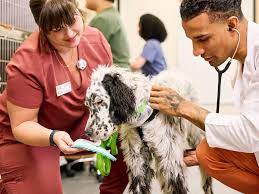
Pet owners who wish their furry friends to live long lives need to understand the correct veterinary checkup frequency. Pet parents commonly believe that their animals will be healthy enough to avoid vet care when they appear well. Pets excel at concealing their illness because they do not show signs of sickness until their condition has become severe.
According to this guide you can determine your pet’s required veterinary visits by considering their age group and medical condition together with their daily activities as well as essential indications requiring urgent attention.
How Often Should Healthy Pets See the Vet?
- Puppies & Kittens (0-1 Year)
Every 3-4 weeks until 16 weeks old
Why? They need:
- Core vaccinations (rabies, distemper, etc.)
- Deworming & parasite prevention
- Early socialization & behavior checks
- Adult Dogs & Cats (1-7 Years)
At least once a year for a wellness exam
The check includes:
- The veterinary evaluation includes careful examination of body weight alongside assessment of teeth along with heart condition and skin condition.
- Booster shots (if needed)
- Fecal test for parasites
- Senior Pets (7+ Years)
Aging pets face age-related problems at a quicker pace so they need check-ups every six months.
Common senior tests:
- Bloodwork (kidney/liver function)
- Arthritis screening
- Thyroid checks
Various Pets Need Regular Veterinary Check Ups at Shorter Intervals
Some pets require extra care. The veterinary appointments for your pet should occur every three to six months when any of these conditions exist:
- Chronic conditions (diabetes, allergies, heart disease)
- A history of cancer or organ problems
- Breed-specific risks (e.g., Bulldogs with breathing issues)
Warning Signs Your Pet Needs the Vet NOW
Poor health crises may occur despite veterinary follow-ups being scheduled. Take your pet to immediate veterinary care if the animal displays any symptoms including:
- Difficulty breathing accompanied by panting,
- Wheezing
- Blue gums
- Sudden paralysis
- Extreme weakness
- Seizures or collapses
- Bloated abdomen
- Retching.
Your pet needs emergency veterinary care if they struggle with breathing while panting and wheezing with blue-colored gums.
A distended belly along with retching indicates GDV is occurring in dogs.
Your pet is at risk if it ingests toxic substances including chocolate and xylitol or rat bait or other poisons.
How to Save on Vet Costs Without Skipping Care
Regular preventive healthcare acts as a cost-saving measure throughout the course of time. Try the following:
- The coverage of costs for emergencies and routine care belongs to pet insurance.
- Some clinics offer Wellness plans which provide discounted bundle packages to their patients.
- Vet telehealth (for minor concerns)
Final Thoughts:
Better Safe Than Sorry!
Similar to humans, pets require routine medical examinations to discover healthcare issues at an early stage. The need for yearly exams becomes clear when a disease gets discovered before it becomes untreatable.
Placing reminders on your calendar should become a post-visit routine to schedule the following checkup for your pet.


